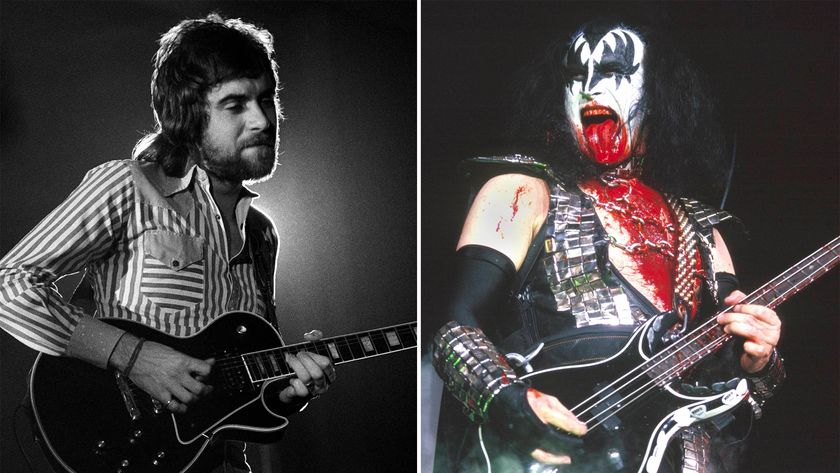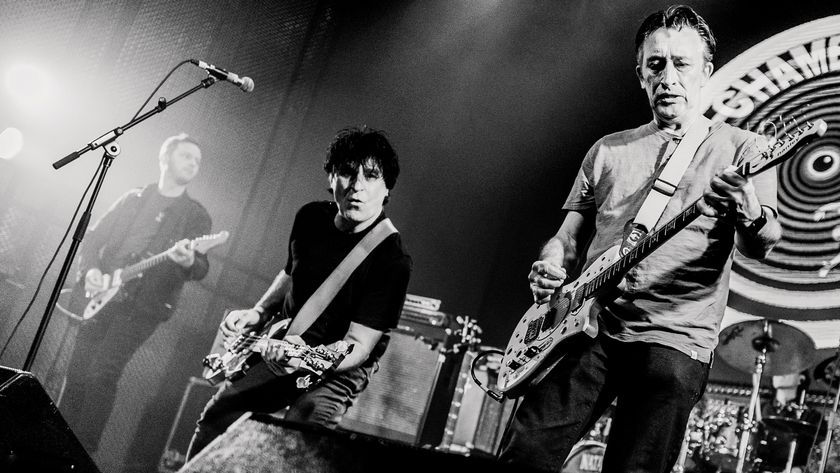Pixies: Natural Magic
Weird and wonderful as they’ve ever been, the Pixies throw us through yet another loop with Beneath The Eyrie.

If there’s one defining trend we can pin to the 2010s, it’s been... Nostalgia. Perhaps because the rest of the world is in goddamn shambles right now, pop-culture has largely shifted its focus to re-appreciating the gems of our past – whether that’s in cinema (Star Wars, Jurassic World and Ghostbusters are all titans of the present-day box office), TV (though it’s a new property, the whole allure of Stranger Things is its retro flavouring) or music; this year alone, we’ve seen chart-destroying albums drop from Weezer, Dream Theater and the Backstreet Boys – all bands who ostensibly peaked in the ‘90s, but have enjoyed wickedly lucrative comebacks as of late.
If there’s one release that will send yesteryear’s music fans into a tizzy, though it’s the latest set of oddball bangers from the Pixies – by and large, the definitive ‘90s alt-rock band. Their seventh full-length (and third since reuniting in ’04), Beneath The Eyrie is 100 percent peak Pixies: belting, bulbous vocals; numbing, overdriven riffs; and goosebump-inducing loud-soft dynamics.
It’s everything we’ve come to love from the Boston-native foursome, with no frills, gimmicks or game-changing quirks. And really, that’s all we could ask from the Pixies. That’s all we want.
“It’s a snapshot of what the four of us were like when we were making this album,” declares lead guitarist Joey Santiago. “It’s us being honest with ourselves, y’know? Knowing when to sound Pixies-ish, when to not sound Pixies-ish; branching out, branching in... Whatever suited us for this record. We did what we could, and I think what we did is pretty good! We didn’t want to pretend to be something we aren’t – we didn’t step into the studio with an agenda, other than to record an album.”
Of course, when you’ve had everyone from Kurt Cobain to David Bowie laud your sound as the best thing to happen in alt-rock history, you can afford to lean on your past to keep trucking along. And though Beneath The Eyrie sounds distinctively fresh, it’s definitely a Pixies record, through and and through. Because after all, they are the Pixies – that’s what they do best.
“Y’know, we’ve never thought about making a Dark Side Of The Moon kind of concept record,” Santiago chuckles. “Not yet, anyway! That would be interesting. But yeah, it’s just whatever we felt like doing in the studio – like an all-Pixies radio station, y’know?”
Like they did with 2016’s Head Carrier, the Pixies recruited producer Tom Dalgety to help them lay Beneath The Eyrie down. And despite Dalgety’s relative youth – his first produced record, the self-titled Royal Blood debut, landed in 2014 – he manages to squeeze out the perfect reflection of the Pixies at their peak as a force of ‘90s-channelling fury, down to the rough, analogue atmospherics that flourish the backing tracks – a trope long abandoned in the age of digital recording (Beneath The Eyrie was in fact recorded digitally, if you’re wondering).
Get The Pick Newsletter
All the latest guitar news, interviews, lessons, reviews, deals and more, direct to your inbox!
“We knew we wanted to work with him again because we just had such a great time doing Head Carrier together,” Santiago explains. “He’s got such a great sensibility – he knows what makes us tick, y’know? He knows everyone’s personalities. Because there’s other things to producing a record than putting sounds on – for lack of a better word these days – tape. First and foremost, the producer’s role is to know the know the band – know how to engage with us and get the best out of us. There are a lot of people that can make us sound great, but if we don’t get along with them, we don’t want to work with them.
“We knew instantly when we met Tom that he was going to work on the record. Within the first five minutes of having dinner with him in Toronto, we were like, ‘Alright, wrap it up! This is our guy!’ He’s friendly, he’s affable, and he’s all that we could ask for in the studio.”
Aside from the heart-on-sleeve production and punishingly earwormish choruses (courtesy of the one and only Francis Black), Beneath The Eyrie’s biggest charm is its simultaneously bright and gritty guitar parts. Santiago wreaks a unique kind of havoc on his fretboard, wherein he plays typically clean and pop-adjacent lines with the ferociousness of a death-metaller.
“It was all done on the black Les Paul that I’ve been using live,” he tells us. “It’s a custom ’57 reissue – it’s historic, or whatever – and there’s just another level to that Gibson. I hardly ever used the Bigsby, but y’know, I like to pretend that it’s contributing some kind of effect to the sound because it’s just so heavy. And for the clean tones, I still use my 1965 ES-345; it’s always been my go-to clean guitar because it has a really nice, chimey sound. We tried to stick to those two guitars – sometimes I tracked with a Jazzmaster, but only on the overdubs – and those are what I use live. Because ultimately, we want to take this record and give it the best representation we can in the live show.”
In the way of effects, Santiago worked with a particularly bare-bones setup. He’s on the ‘less is more’ side of the age-old argument, and running a signal chain that’s still fully analogue in spite of the digital recording revolution, an unreticent champion that if it ain’t broke, he ain’t fixin’ it.
“I love this one wah pedal I have,” Santiago muses. “I use it more for a filter effect – it’s the DOD FX-17 Wah-Volume pedal, and it’s just this big metal slab with a rocker. I also have a Fulltone OCD in my setup, but for this record, I used Tom’s [Crowther] Hotcake – it’s just great for that crunchy sort of... Actually, that reminds me, I need to get one for myself! Thanks for that.”
No worries. So where were we? “Oh, right... And then I used a Maxon [AD999] Delay, which does pretty much everything: it’s a delay, a fuzz, a pitchfork, a harmoniser – that’s the pedal you’ll want to use to get some really otherworldly sounds out of your guitar. If you hear something on the record and go, ‘That is so weird,’ more often than not it’s because of that pedal.”
Another trick that’s remained up Santiago’s sleeve since the ‘90s is his penchant for wabi-sabi: a longstanding technique in traditional Japanese art that sees imperfections as part of the beauty in creation. Rather than meticulously polish – sometimes, when an artwork is peculiarly faultless as is, that means adding errant brushstrokes on purpose to give it a sense of human touch. The concept itself comes from the Buddhist teaching of the three marks of existence: impermanence, suffering and emptiness.
Such has remained a linchpin of the Pixies’ artistry. Bum notes, vocal cracks and tuning errors are all embraced, rather than scrubbed out in post; it reflects their determination to make the record sound as honest and human as it can be – after all, when you’re watching the Pixies perform live, there’s no going back to re-do an off-timed strum or edit out a cough. And though they haven’t actively thrown in any subliminal stuff-ups for listeners to dive in and find, they were notably blasé when it came to polishing Beneath The Eyrie.
“The wabi-sabi is more-or-less an accident that happens,” Santiago admits, “But when it does, it gets kept. It’s one of those things where you’re like, ‘Oops, what was that? ...Do it again!’ There was one moment where, for some reason, the electricity feeding into my wah pedal was making it sound weird – it sounded like nothing we’d ever heard. And we were trying to fix it, like, ‘This is not the way it’s supposed to sound!’ It had this lower octave going on – this really dark, hummy sort of vibe – and instead of fixing it, I stepped in and went, ‘Hold on, let’s give this a shot.’ And it totally worked!”

Ellie Robinson is an Australian writer, editor and dog enthusiast with a keen ear for pop-rock and a keen tongue for actual Pop Rocks. Her bylines include music rag staples like NME, BLUNT, Mixdown and, of course, Australian Guitar (where she also serves as Editor-at-Large), but also less expected fare like TV Soap and Snowboarding Australia. Her go-to guitar is a Fender Player Tele, which, controversially, she only picked up after she'd joined the team at Australian Guitar. Before then, Ellie was a keyboardist – thankfully, the AG crew helped her see the light…

“I had to use the same microphone that Gene Simmons used with all the blood coming out of his mouth. Can you imagine that!”: Mick Rogers recalls Kiss supporting Manfred Mann's Earth Band in their early days

“Once Dave got his Roland Space Echo, it changed the vibe… that, and a lot of marijuana”: They inspired everyone from Oasis to the Smashing Pumpkins. Now English post-punk luminaries the Chameleons are back for more








